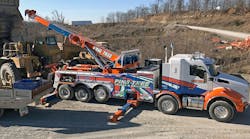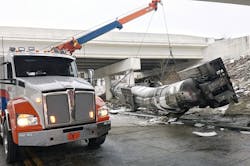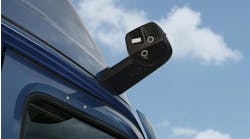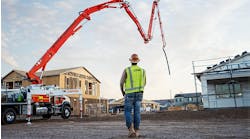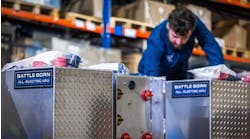Company: Pine Tree Towing and Recovery, Cambridge, OH
Operation: Offering 24/7 truck towing and roadside repair service, Pine Tree is southeastern Ohio’s largest towing operation. The fleet includes 17 tow vehicles—six are Class 8 units—as well as commercial service vans, medium-duty wreckers, specialty towing trailers, and a refrigerated trailer that can be sent if a reefer truck breaks down.
Challenge: Expand heavier, more extreme towing capabilities and keep equipment running.
If you want to know about maintenance, ask a tow truck fleet — they’re the guys who need to get out reliably to clear away and recover others that have broken down.
“We see a lot of the big ‘lack of maintenance’ items when we’re out there,” said Ron Myers, Pine Tree’s owner. “We’re in this position where if people call us, they’re already having a bad day. Generally, they need help—and we can’t help anyone if we don’t get there.”
The company has been expanding its heavy towing operations and needed equipment to handle extreme jobs more safely.
Solution: Add twin-steer-axle trucks with heavier equipment—and don’t slip when it comes to PMs.
Among its heavy trucks, Pine Tree has two new Kenworth T-880s with big rotator tow booms, a 50-ton unit, and a 75-ton unit. Heavy truck and large-item towing is Pine Tree’s specialty, and those Kenworths feature twin-steer axles—a second, coupled steering axle sits below the back of the cab—and Myers said that offers some key advantages.
The twin-steer axles, which were installed by Simard Suspensions in Canada, help handle the weight of heavy equipment, like the rotators and truck bodies. Twin-steer-axle trucks are more common in Canada, but Myers said they’re gaining in the United States.
“The effective wheelbase is shorter, which allows the truck to turn sharper,” he pointed out. Twin-steers also allow more maneuverability in tight spots, Myers said. The front axle can creep farther off an edge without getting stuck, since they can still back out with their rear wheels.
“With a regular truck, if you put the front axle into a ditch, you’re in a ditch,” he quipped. A twin-steer additionally has another axle of braking power, but the extra axle mainly helps support the heavy equipment.
“You have a truck that weighs 65,000, 75,000 lbs.; it’s like driving a loaded dump truck anywhere you go,” Myers said. With that kind of equipment, “it’s even more critical that you do all the preventive maintenance and so on,” he told Fleet Owner. “They’ve got to be greased—and greased in the right spots.”
Checking thoroughly through trucks in the shop and keeping up with preventive maintenance, or PM, items “does make a big difference,” Myers contended.
Back in the 1990s, every Saturday—which was usually slower for towing jobs—was “maintenance day” for Pine Tree. Trucks would be brought in to be washed and greased, oil changes would be performed for trucks that were due, and so on.
“It was like a ritual,” Myers noted. The company also learned that water damage can be especially crippling to a specialty towing operation. Flooding in 1998 that hit Caldwell, OH, “sent 10 ft. of water through our shops” in that town, he said.
“I don’t think there’s anything more devastating than a flood, short of a fire,” Myers contended, adding that even much smaller bouts with water can mean trouble for trucks.
“If we have a lot of rain, the first opportunity the trucks have to see a grease gun, we grease them,” he stressed. “Nine times out of 10, you’ll push water out of a U-joint; you’ll push water out of a kingpin. It finds its way in there, and the sooner you can get it out, the better.”
